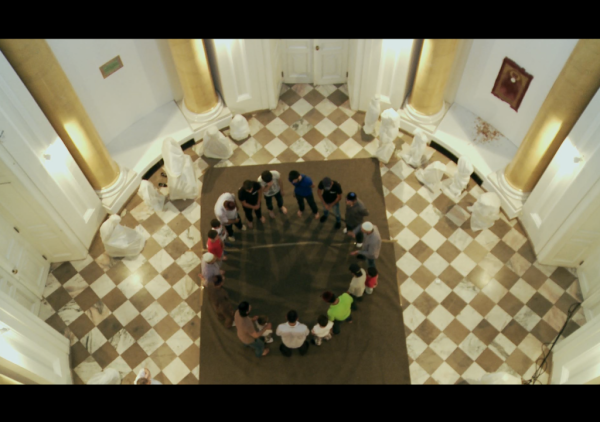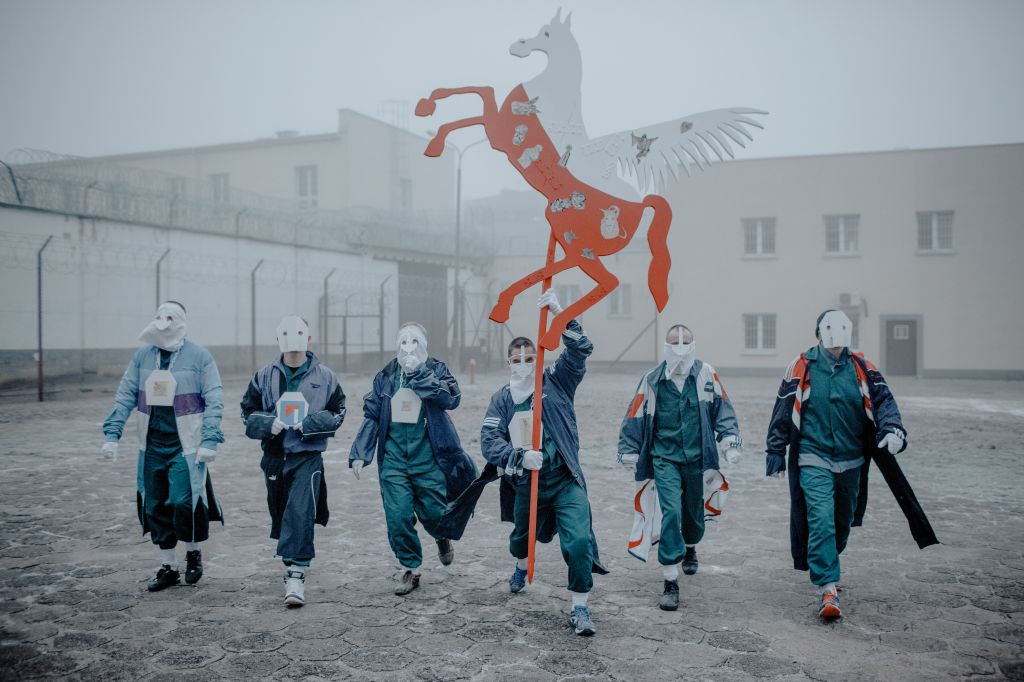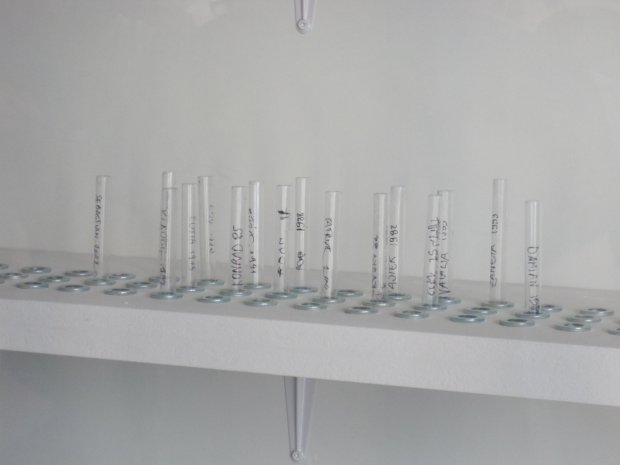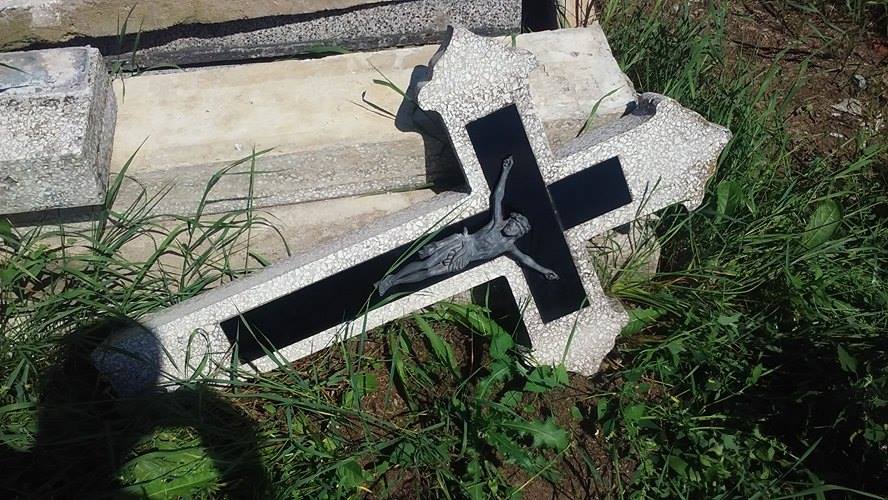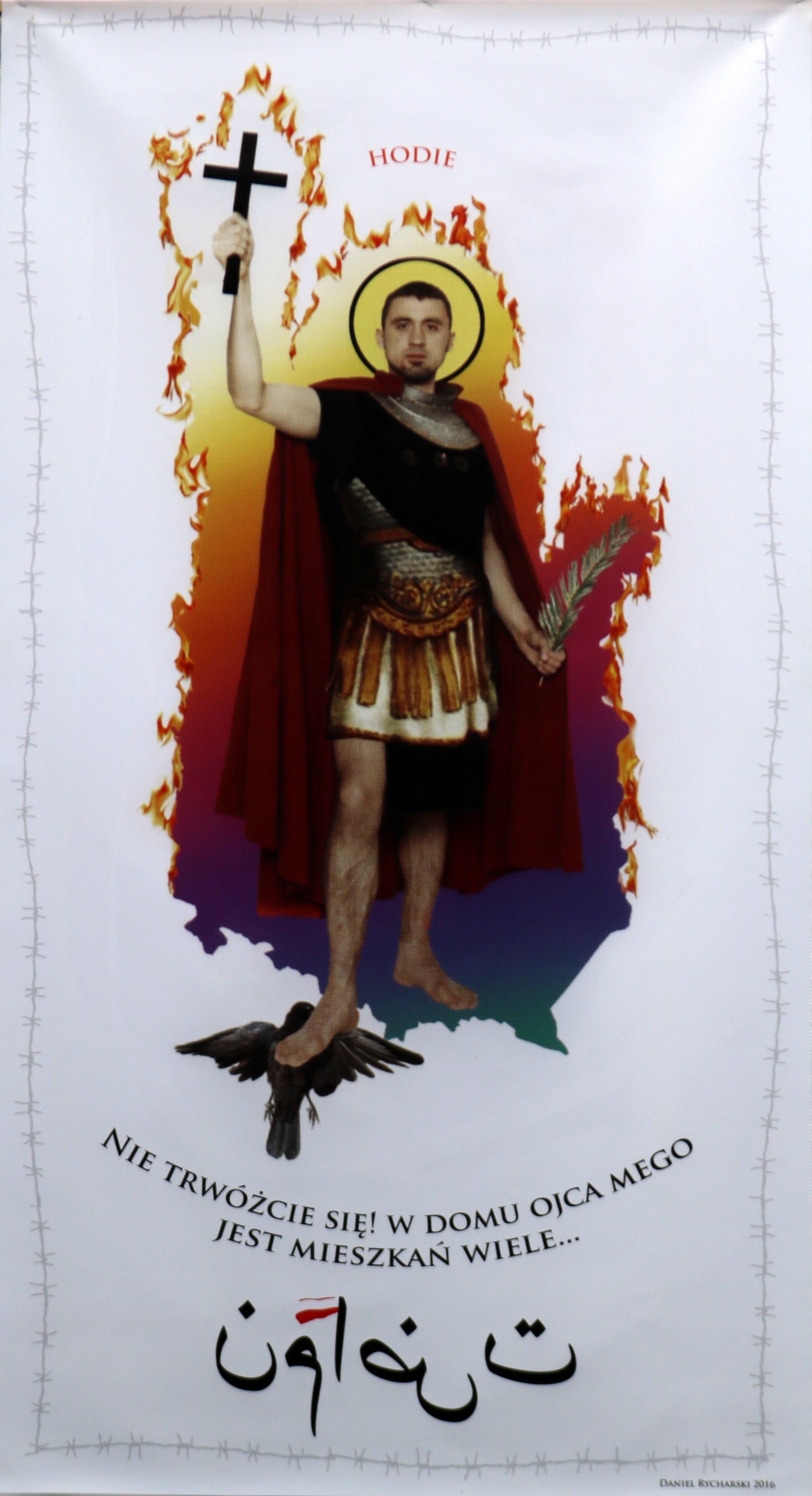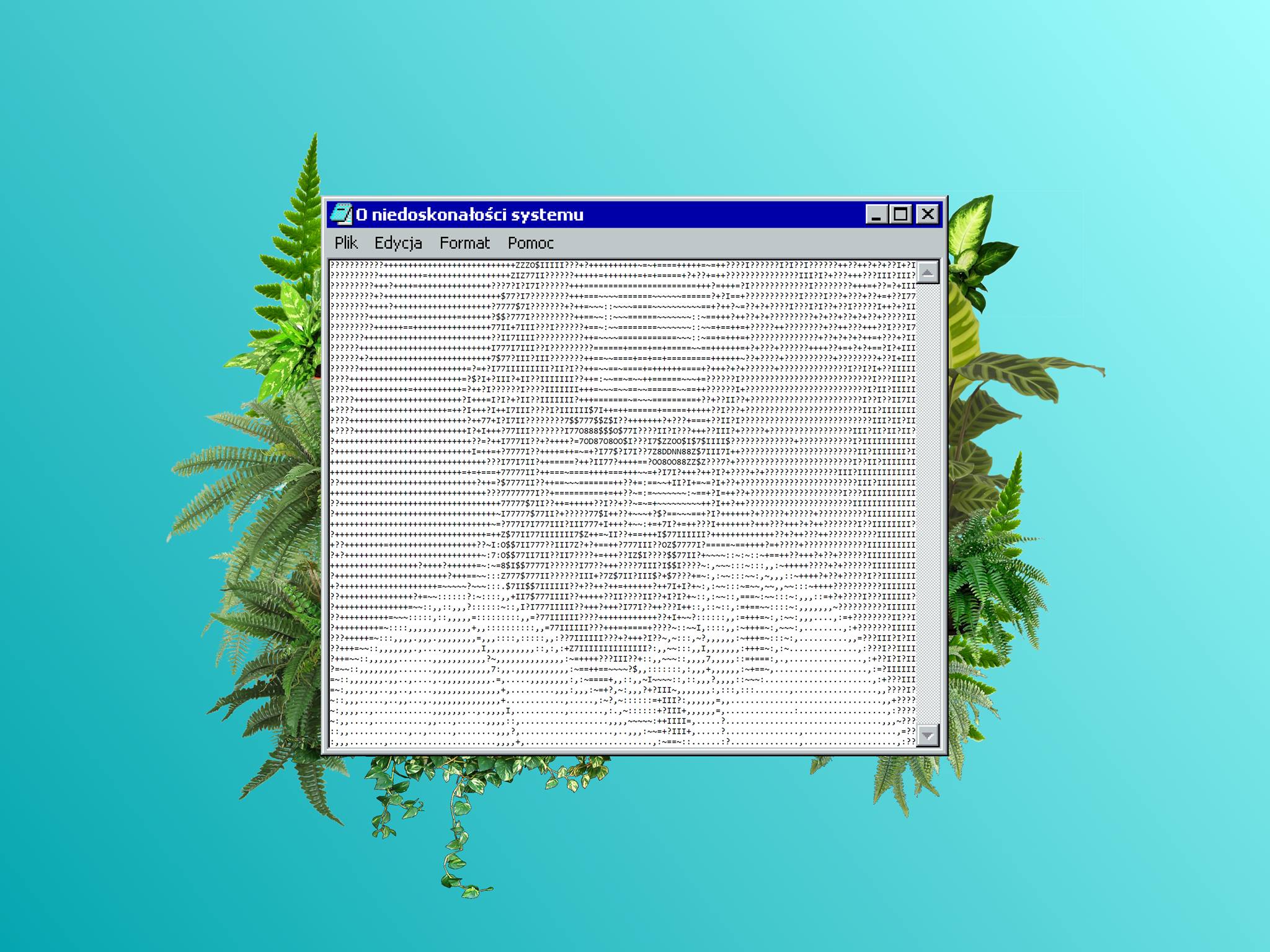Communion in its holy incarnation is delivered as a piece of dough, whereas its secular variation adopts the form of the classic communist battle cry, “Bread and work!” Polish custom has it that a loaf of bread is marked with a cross, dropped on the ground, kissed while it is picked up, and later fed to a stork. A fundamental task of the community is the acquisition and provision of bread in its various forms—there is no question about it. In the Holy Scriptures, such an act is called “feeding the multitude,” which means an allocation of nutritional units across the matrix of a given community. In a secular and technical form, it would thus be a “bread resolution,” with bread distributed akin to pixels across a digital image.
Yet the social sciences do not define communities through the prism of the distribution of staple foodstuffs, but through shared values and norms that combine in a certain way to form the identity of a given community. Another important factor is the individual awareness of affiliation within a larger supra-individual entity, and the willingness to sustain that affiliation. The building material thus belongs to the realm of ideas, even though it is also extremely practical as it manifests itself in activities, ways of spending time, and topics of conversations. Here, the same blow should be dealt that Hegel suffered from Marx: if we recognise that ideas are more important than matter, we lose the possibility to investigate their foundations. We do not know if they are deep, well-laid, frost- and waterproof, etc. Forgetting the material dimension of the community—the fact that it should be based also on the distribution of goods (of various kinds)—is a mistake: if not theoretical then certainly practical. The community-based sharing of values cannot last for very long if we all lose access to things.
The connection between the virtual and material community is invariably recognised by the political right wing. It uses its own characteristic ways to stigmatize and exclude those who are not in possession of slices of bread for various reasons: the unemployed and the poor are driven “to work” using threats of moral discipline or a kick in the back. Those in possession of alimentary provisions are attacked from a different side: immigrants and outcasts are beaten or spat on for their alleged crimes against ideas. The fate of those excluded from the community in both these dimensions is nothing to be envied. The chauvinism of the welfare state—the persistent illness that troubles our times—is synonymous with the political right wing: The exclusion from the community as a distribution network of symbolic values, and as a distribution network of alimentary values, is merged into one. Help is denied due to the culture of the needy, whereas culture is rejected due to the needs of those who represent it. In the face of crisis and the threat to a community’s well being, the right wing does not respond by forming stronger networks of distribution, but by narrowing them, tightening control and supervision.
Somewhat surprisingly, the rituals which encircle communities are also practiced on the other side of the political no man’s land. For a long time, the attention of those who pursued a rational transformation of the world concentrated on the ways of organizing the most horizontal communities possible. They generated reflection on the various ideal forms of direct or participatory democracy, the manner by which to manage diversity and protect difference, as well as the opportunity to equal chances to access power and to disperse responsibility. They also vociferously criticized the habits of non-equality, which we do not in the least want to bring into our shared house like mud on the soles of our shoes. They considered the egalitarian internal purity of the community as a light that would proselytize the unfaithful and renew the face of the earth, the face of this land. They referred to revolutionary communes or remote tribes uncorrupted by capitalism. It is difficult not to notice that such a style of building a utopia is thoroughly conservative. First, it models itself on historically ephemeral entities. Second, it tries to organize such ephemeral entities around itself. For the flame of democratic revolution is not turned towards the world, but instead towards one’s own people, towards those who are already convinced. This situation gives rise to obvious problems with attempts at an expansion: potential recruits are not in possession of an adequate system of norms and values, and therefore it is difficult to burden them with the responsibility of the community. When the founding group weakens, and there are no equally devoted successors, the entire project collapses. The problem of expanding the network and lowering the entry threshold might be one of the gravest political problems of our twisted times: regardless of whether it applies to states, nationalities, local communities, trade unions, or other avant-gardes.
Obviously, I am not negating here the social adventure offered by temporary autonomous zones. Taking into consideration the poor longevity of our existence, those might be the only moments of truly free entertainment. A momentary community is better than no community at all, as it is proved by the popularity of the Sunday séances organized by the Catholic Church and its homologues on other days of the week.
***
It is hard not to notice that Polish culture is not arranged in a way that particularly favors community. Hierarchy and unequal access to culture are our proverbial daily bread. The Polish state is not particularly cultural, but still we should be thankful that some public institutions still exist instead of being privatized and transformed into discount shops. Management pursued by the religious authorities consists in establishing borders and entry thresholds, rather than expanding the borders of what is shared. Inequalities in access to culture perpetuate ideological divisions. Exclusion from material circulations breaks the circulations of norms and values, while norms and values serve the goal of cultivating class identities instead of providing a stimulus for democratization. Turning culture into a tool of distinction—building barriers—is part of the problem rather than a solution. The cold war for a bread roll between art and society is fortunately yielding a place to other forms of contact; numerous exchanges take place at the toll gates, but unfortunately the channels of distribution are still not unobstructed enough. What can we do about it? The answers are manifold. The practice of Resolution of Bread hints at several ways of ploughing that guarantee with relatively abundant crops.
Ideology manifests itself particularly insidiously in form: democracy and levelling inequalities in access to culture cannot therefore form merely the content of the work, but may equally well (or even better) express themselves in how the work is presented. Bread Resolution likes to deliver data on a magnetic disk of a hard drive or on the cold plate of a memory card. Our goal is to achieve success understood rather in the categories of a volume of prepared and distributed meals than in elaborated quality norms. Attachment to egalitarian forms of distribution releases us from the obligation of obsessive checking if the distributed content is politically adequate (whatever it means). I think it is.
***
Of the plethora of divisions that trouble the people of the Polish land, the antagonism between the faction oriented towards the import of values and the faction oriented to domestic and traditional produce is particularly acute. For various reasons, the former tends to embrace people from the higher social strata. It also includes outstanding artists and intellectuals, who find it difficult to interact with locally produced goods. It is all too easy to identify the “Polish people” with being unpleasant and unfit for the community in which we would like to have fun. A pilgrim’s cursor should be carried across the country to indicate the files and applications that merit downloading. Although the LCD screen separates us from a material pilgrimage through the North European Plain Lowland, we are connected with connectivity and the pilgrimage takes course via a router. The router becomes a bakery. Transferring the Pope onto the LCD screen does not flatten his papal figure, but we may even say that it adds new dimensions. On the Internet, the Pope becomes the Pope even “more,” since the gesture of a raised hand—previously directed at a specific community—now becomes a gesture directed at a population of anything, at the Internet of things, at any form of social life that wishes to become plugged. Blurring the differences between “them” and us” is difficult. Therefore, it is much easier to do it in the presence of alimentary products whose undisturbed distribution makes it easier to enjoy the mutual presence without grievances about appropriate data transfer.
Beyond a small community of bread that we share between us when we hold hands there is also a large community of bread, which we call, culture. A conservative strategy consists in closing communities, limiting distribution, increasing the costs of participation. A progressive strategy consists in facilitating exposition, levelling mounds and cavities, searching for new cultural ecosystems and cultivating the existing ones according to the norms of the BitTorrent network: to each according to their needs, from each according to their ability. In the vision described here, a well-configured server (a word that also denotes a person who serves us something) is a device that merits imitating. It is not a post-political vision in the literal sense, but rather a post-human vision in the Latourian sense: treating the universe as points which can potentially, and with effort, become connected to form ties and sets (set phrases, for instance), which we have never had a chance to experience before. The goal is not homogenization, but a multiplication of surprises.
In the borough (in Polish: gmina, from the German Gemeinde, meaning “commune” or “community”) where I come from, the bakery was located between the cemetery and the rubber shoe factory. One could feel tempted to draw a conclusion that the Bread Resolution is a space between labor and the grave, yet I will refrain from such a conclusion.
***
Piotr Puldzian Płucienniczak is an artist, cultural animator, recipient of a PhD degree in sociology. Member of the Bread Resolution collective.
